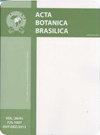基于新ssr的豆科巴鲁双翅鸟(baru Dipteryx alata, Fabaceae)种群的分子洞察
IF 1.1
4区 生物学
Q4 PLANT SCIENCES
引用次数: 0
摘要
本文章由计算机程序翻译,如有差异,请以英文原文为准。
Molecular insight for baru Dipteryx alata (Fabaceae) populations based on novel SSRs
Baru tree ( Dipteryx alata ) is an arboreal, fruitful plant native to the Cerrado biome with an important socioeconomic impact. Populations of this species are a good model to study anthropogenic disturbances on the biome through the genetic information. In this study, we developed seven new polymorphic microsatellite markers for D. alata, using an enriched genomic library. We performed loci characterization in three populations, obtaining a total of 49 alleles, with an average of 5 to 5.57 alleles per locus. A significant content of polymorphic information was obtained, as indicated by the average expected heterozygosity ( uHE ), with a total average of 0.58 to 0.65 per locus. The average value of the observed heterozygosity ( Ho ) was also high, with a total average of 0.73 to 0.85 per locus. Some of the loci are in linkage disequilibrium, such as DalatG6 with DalatB3, DalatH3 and DalatB4. The estimate of the combined loci for the probability of paternity exclusion obtained an average value of 1.00 for all loci, and the average combined probability of identity, the values were (1.2 10^-5 ) to (4.4 10^-6 ). All markers are informative and suitable for studies on genetic diversity and population structure, aiming at the conservation and management of the species.
求助全文
通过发布文献求助,成功后即可免费获取论文全文。
去求助
来源期刊

Acta Botanica Brasilica
PLANT SCIENCES-
CiteScore
2.30
自引率
9.10%
发文量
32
审稿时长
6-12 weeks
期刊介绍:
Experimental, theoretical and applied papers on all aspects of plant (including algae) and fungi biology are welcome. The submitted manuscript or its essential content must not have been published previously or be under consideration for publication elsewhere. Contributions should be substantial, written in high-quality English and show general interest. We expect that the submitted manuscript presents a great novelty in Botany, and this should attract a wide audience. Considering this, case studies are only considered if the narrative and implications are provided to be of general interest. Thus, manuscripts that report aspects of local interest are discouraged unless the implications of the findings are wide-reaching. Manuscripts with agronomic subjects are expected to contain a substantial amount of basic plant biology. Please see below some details for specific area.
 求助内容:
求助内容: 应助结果提醒方式:
应助结果提醒方式:


